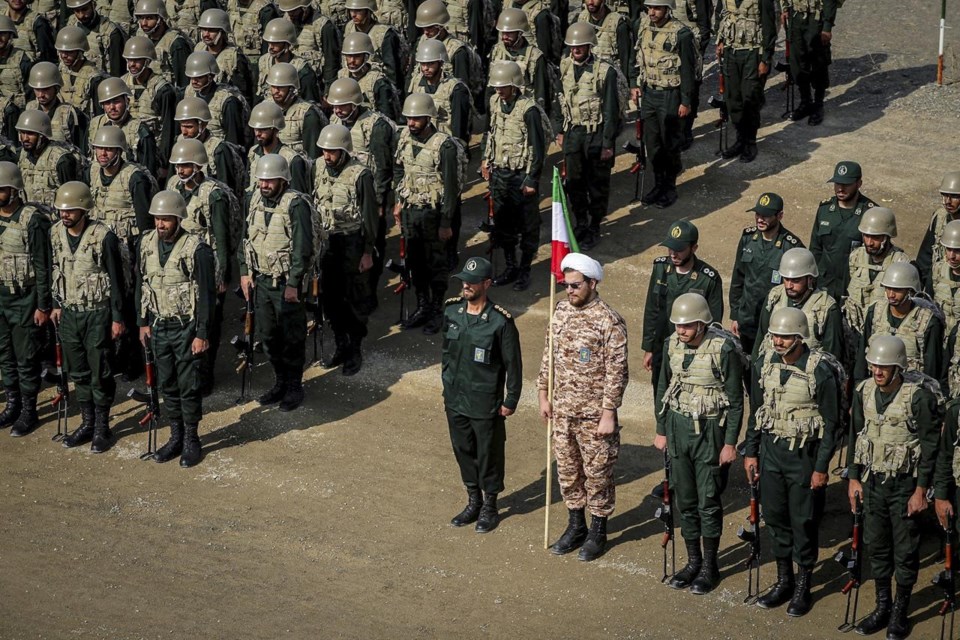DUBAI, United Arab Emirates (AP) ŌĆö As protests rage at home, Iran's theocratic government is flexing its military muscle abroad: Tehran has supplied drones to Russia that killed Ukrainian civilians, run drills in a border region with Azerbaijan and bombed Kurdish positions in Iraq.
Those moves show Iran's leaders trying to rally hard-line support within the country as demonstrations continue over , a 22-year-old woman who died in the custody of the countryŌĆÖs morality police.
They also serve as a reminder to the wider Middle East and the West that Iran's government remains willing to use force both abroad and at home to stay in power.
Further raising the risk of destabilization is Iran's nuclear program. Tehran now has enough highly enriched uranium to build an atomic bomb if it chooses ŌĆö and continues to make more as .
Online videos from Iran show people from all walks of life, from school-age children to the elderly, taking part in the protests that activists say have swept across over 100 cities since Amini's death. Women have removed their hijabs in demonstrations and in the course of the daily life in Tehran.
Even the threat of arrest, beatings and even deadly violence by security forces haven't quelled the anger as Iran faces worsening economic woes. Activist groups say thousands already have been detained and over 200 people killed.
Iran's government, meanwhile, has tried to provide counter-programming, rallying flag-waving men and women in the all-encompassing black chador for events in Tehran and elsewhere.
Rallying its supporters remains crucial for Iran's government as it faces its worst crisis since . As part of that effort, Iran has tried to show in recent weeks that it is able to strike back at its enemies, whether real or perceived.
Its first strikes came in late September, as Iran's paramilitary Revolutionary Guard unleashed drone and missile attacks on areas that are home to Kurdish separatists living across the border in Iraq. Kurdish officials say those attacks killed at least 16 people, including one American citizen, and wounded dozens more.
At the time, Iran alleged ŌĆö without providing evidence ŌĆö that Kurdish separatists sparked the demonstrations over the death of Amini, a Kurd. Rumors persist of a heavy military presence in western Iran as security forces clashed repeatedly with demonstrators in Kurdish areas.
There has also been military activity on Iran's northern border with Azerbaijan, where the Revolutionary Guard, answerable only to Supreme Leader Ayatollah Ali Khamenei, has run military drills over several days.
On Wednesday, the semiofficial Tasnim news agency published video of Guard troops installing pontoon bridges across the Aras River on the border, then driving tanks and trucks across it.
Azerbaijan has been locked in cyclical fighting with Armenia, with the latest round
Azerbaijan's ties to Israel have angered Tehran, particularly as 69% of all its major arms imports came from Israel in the period between 2016 to 2020, according to the Stockholm International Peace Research Institute. Iran also wants to maintain its 44-kilometer (27-mile) border with landlocked Armenia ŌĆö something that could be threatened if Azerbaijan seizes new territory through warfare.
Then there's Russia's war on Ukraine. As Moscow chewed through its stockpile of precision-guided munitions in the monthslong war, it turned to Iran to supply it with low-cost ŌĆ£suicideŌĆØ drones. They function like a slow-moving cruise missile, buzzing by close to the ground before diving in and exploding against a target on impact.
In Kyiv, Ukraine's capital, ŌĆö known for their distinctive triangle-shaped design ŌĆö have blown up apartment buildings and other targets. Iran and Russia have denied Tehran has supplied the drones ŌĆö but Khamenei in a speech on Wednesday telegraphed his approval of their deadly capabilities on the battlefield.
ŌĆ£A few years ago, when photographs of our advanced missile and drones were released, some said that they were Photoshopped," Khamenei said, according to a transcript on his official website. "But now theyŌĆÖre saying: ŌĆśIranian drones are very dangerous, why are you selling it to so and so? Why are you giving it to so and so?ŌĆÖŌĆØ
.
Meanwhile, Iran's nuclear program continues to accumulate more highly enriched uranium.
Amid the continuing demonstrations, U.S. State Department spokesperson Ned Price recently described efforts to create a road map to restore Iran's tattered 2015 nuclear deal with world powers as
While critics of Iran's crackdown on protesters applaud Washington's shift in language, a prolonged failure to restore the nuclear deal also raises the nuclear proliferation risks posed by Tehran ŌĆö potentially another trigger point for regional tensions.
Iran now enriches uranium up to 60% purity ŌĆö a short step away from weapons-grade levels of 90%. , something once considered taboo.
Israel has warned it will never allow Iran to obtain a nuclear weapon ŌĆö and the country has carried out airstrikes in the past to . That opens the risk for a wider conflict even as tensions over Iran's program have set the region at .
Meanwhile, the United States continues to signal it remains ready to use force in the region if needed. begun under President Donald Trump's administration have continued under President Joe Biden.
And early Thursday, the U.S. military's Central Command acknowledged ŌĆö an unusual visit to one of America's top weapons in its atomic arsenal near Iran.
___
EDITORŌĆÖS NOTE ŌĆö Jon Gambrell, the news director for the Gulf and Iran for The Associated Press, has reported from each of the Gulf Cooperation Council countries, Iran and other locations across the world since joining the AP in 2006. Follow him on Twitter at www.twitter.com/jongambrellAP.
Jon Gambrell, The Associated Press



